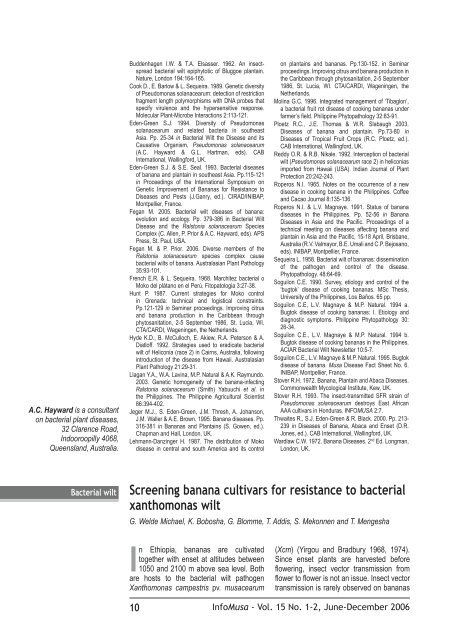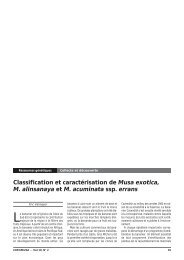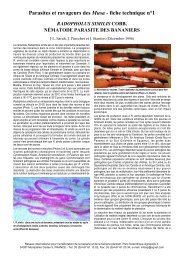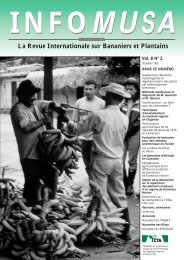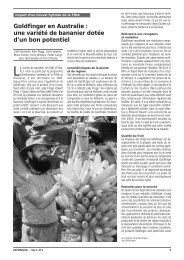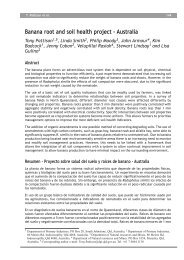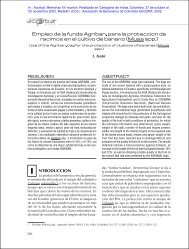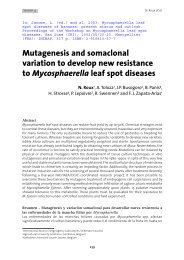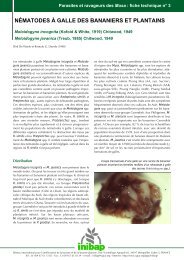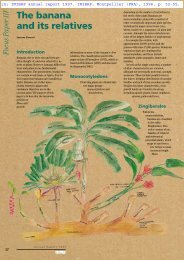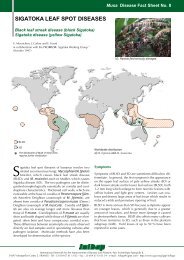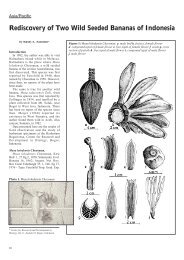Screening banana cultivars for resistance to bacterial ... - Musalit
Screening banana cultivars for resistance to bacterial ... - Musalit
Screening banana cultivars for resistance to bacterial ... - Musalit
You also want an ePaper? Increase the reach of your titles
YUMPU automatically turns print PDFs into web optimized ePapers that Google loves.
A.C. Hayward is a consultant<br />
on <strong>bacterial</strong> plant diseases,<br />
32 Clarence Road,<br />
Indooroopilly 4068,<br />
Queensland, Australia.<br />
Bacterial wilt<br />
Buddenhagen I.W. & T.A. Elsasser. 1962. An insectspread<br />
<strong>bacterial</strong> wilt epiphy<strong>to</strong>tic of Bluggoe plantain.<br />
Nature, London 194:164-165.<br />
Cook D., E. Barlow & L. Sequeira. 1989. Genetic diversity<br />
of Pseudomonas solanacearum: detection of restriction<br />
fragment length polymorphisms with DNA probes that<br />
specify virulence and the hypersensitive response.<br />
Molecular Plant-Microbe Interactions 2:113-121.<br />
Eden-Green S.J. 1994. Diversity of Pseudomonas<br />
solanacearum and related bacteria in southeast<br />
Asia. Pp. 25-34 in Bacterial Wilt the Disease and its<br />
Causative Organism, Pseudomonas solanacearum<br />
(A.C. Hayward & G.L. Hartman, eds). CAB<br />
International, Walling<strong>for</strong>d, UK.<br />
Eden-Green S.J. & S.E. Seal. 1993. Bacterial diseases<br />
of <strong>banana</strong> and plantain in southeast Asia. Pp.115-121<br />
in Proceedings of the International Symposium on<br />
Genetic Improvement of Bananas <strong>for</strong> Resistance <strong>to</strong><br />
Diseases and Pests (J.Ganry, ed.). CIRAD/INIBAP,<br />
Montpellier, France.<br />
Fegan M. 2005. Bacterial wilt diseases of <strong>banana</strong>:<br />
evolution and ecology. Pp. 379-386 in Bacterial Wilt<br />
Disease and the Rals<strong>to</strong>nia solanacearum Species<br />
Complex (C. Allen, P. Prior & A.C. Hayward, eds). APS<br />
Press, St. Paul, USA.<br />
Fegan M. & P. Prior. 2006. Diverse members of the<br />
Rals<strong>to</strong>nia solanacearum species complex cause<br />
<strong>bacterial</strong> wilts of <strong>banana</strong>. Australasian Plant Pathology<br />
35:93-101.<br />
French E.R. & L. Sequeira. 1968. Marchitez <strong>bacterial</strong> o<br />
Moko del plátano en el Perú. Fi<strong>to</strong>pa<strong>to</strong>logia 3:27-38.<br />
Hunt P. 1987. Current strategies <strong>for</strong> Moko control<br />
in Grenada: technical and logistical constraints.<br />
Pp.121-129 in Seminar proceedings. Improving citrus<br />
and <strong>banana</strong> production in the Caribbean through<br />
phy<strong>to</strong>sanitation, 2-5 September 1986, St. Lucia, WI.<br />
CTA/CARDI, Wageningen, the Netherlands.<br />
Hyde K.D., B. McCulloch, E. Akiew, R.A. Peterson & A.<br />
Diatloff. 1992. Strategies used <strong>to</strong> eradicate <strong>bacterial</strong><br />
wilt of Heliconia (race 2) in Cairns, Australia, following<br />
introduction of the disease from Hawaii. Australasian<br />
Plant Pathology 21:29-31.<br />
Llagan Y.A., W.A. Lavina, M.P. Natural & A.K. Raymundo.<br />
2003. Genetic homogeneity of the <strong>banana</strong>-infecting<br />
Rals<strong>to</strong>nia solanacearum (Smith) Yabuuchi et al. in<br />
the Philippines. The Philippine Agricultural Scientist<br />
86:394-402.<br />
Jeger M.J., S. Eden-Green, J.M. Thresh, A. Johanson,<br />
J.M. Waller & A.E. Brown. 1995. Banana diseases. Pp.<br />
316-381 in Bananas and Plantains (S. Gowen, ed.).<br />
Chapman and Hall, London, UK.<br />
Lehmann-Danzinger H. 1987. The distribution of Moko<br />
disease in central and south America and its control<br />
In Ethiopia, <strong>banana</strong>s are cultivated<br />
<strong>to</strong>gether with enset at altitudes between<br />
1050 and 2100 m above sea level. Both<br />
are hosts <strong>to</strong> the <strong>bacterial</strong> wilt pathogen<br />
Xanthomonas campestris pv. musacearum<br />
10<br />
on plantains and <strong>banana</strong>s. Pp.130-152. in Seminar<br />
proceedings. Improving citrus and <strong>banana</strong> production in<br />
the Caribbean through phy<strong>to</strong>sanitation, 2-5 September<br />
1986, St. Lucia, WI. CTA/CARDI, Wageningen, the<br />
Netherlands.<br />
Molina G.C. 1996. Integrated management of ‘Tibaglon’,<br />
a <strong>bacterial</strong> fruit rot disease of cooking <strong>banana</strong>s under<br />
farmer’s field. Philippine Phy<strong>to</strong>pathology 32:83-91.<br />
Ploetz R.C., J.E. Thomas & W.R. Slabaugh 2003.<br />
Diseases of <strong>banana</strong> and plantain. Pp.73-80 in<br />
Diseases of Tropical Fruit Crops (R.C. Ploetz, ed.).<br />
CAB International, Walling<strong>for</strong>d, UK.<br />
Reddy O.R. & R.B. Nikale. 1992. Interception of <strong>bacterial</strong><br />
wilt (Pseudomonas solanacearum race 2) in heliconias<br />
imported from Hawaii (USA). Indian Journal of Plant<br />
Protection 20:242-243.<br />
Roperos N.I. 1965. Notes on the occurrence of a new<br />
disease in cooking <strong>banana</strong> in the Philippines. Coffee<br />
and Cacao Journal 8:135-136.<br />
Roperos N.I. & L.V. Magnaye. 1991. Status of <strong>banana</strong><br />
diseases in the Philippines. Pp. 52-56 in Banana<br />
Diseases in Asia and the Pacific. Proceedings of a<br />
technical meeting on diseases affecting <strong>banana</strong> and<br />
plantain in Asia and the Pacific, 15-18 April, Brisbane,<br />
Australia (R.V. Valmayor, B.E. Umali and C.P. Bejosano,<br />
eds). INIBAP, Montpellier, France.<br />
Sequeira L. 1958. Bacterial wilt of <strong>banana</strong>s: dissemination<br />
of the pathogen and control of the disease.<br />
Phy<strong>to</strong>pathology. 48:64-69.<br />
Soguilon C.E. 1990. Survey, etiology and control of the<br />
‘bug<strong>to</strong>k’ disease of cooking <strong>banana</strong>s. MSc Thesis,<br />
University of the Philippines, Los Baños. 65 pp.<br />
Soguilon C.E, L.V. Magnaye & M.P. Natural. 1994 a.<br />
Bug<strong>to</strong>k disease of cooking <strong>banana</strong>s: I. Etiology and<br />
diagnostic symp<strong>to</strong>ms. Philippine Phy<strong>to</strong>pathology 30:<br />
26-34.<br />
Soguilon C.E., L.V. Magnaye & M.P. Natural. 1994 b.<br />
Bug<strong>to</strong>k disease of cooking <strong>banana</strong>s in the Philippines.<br />
ACIAR Bacterial Wilt Newsletter 10:5-7.<br />
Soguilon C.E., L.V. Magnaye & M.P. Natural. 1995. Bug<strong>to</strong>k<br />
disease of <strong>banana</strong>. Musa Disease Fact Sheet No. 6.<br />
INIBAP, Montpellier, France.<br />
S<strong>to</strong>ver R.H. 1972. Banana, Plantain and Abaca Diseases.<br />
Commonwealth Mycological Institute, Kew, UK.<br />
S<strong>to</strong>ver R.H. 1993. The insect-transmitted SFR strain of<br />
Pseudomonas solanacearum destroys East African<br />
AAA <strong>cultivars</strong> in Honduras. INFOMUSA 2:7.<br />
Thwaites R., S.J. Eden-Green & R. Black. 2000. Pp. 213-<br />
239 in Diseases of Banana, Abaca and Enset (D.R.<br />
Jones, ed.). CAB International, Walling<strong>for</strong>d, UK.<br />
Wardlaw C.W. 1972. Banana Diseases. 2 nd Ed. Longman,<br />
London, UK.<br />
<strong>Screening</strong> <strong>banana</strong> <strong>cultivars</strong> <strong>for</strong> <strong>resistance</strong> <strong>to</strong> <strong>bacterial</strong><br />
xanthomonas wilt<br />
G. Welde Michael, K. Bobosha, G. Blomme, T. Addis, S. Mekonnen and T. Mengesha<br />
(Xcm) (Yirgou and Bradbury 1968, 1974).<br />
Since enset plants are harvested be<strong>for</strong>e<br />
flowering, insect vec<strong>to</strong>r transmission from<br />
flower <strong>to</strong> flower is not an issue. Insect vec<strong>to</strong>r<br />
transmission is rarely observed on <strong>banana</strong>s<br />
InfoMusa - Vol. 15 No. 1-2, June-December 2006
grown above 1700 masl, but it occurs at<br />
lower elevations.<br />
The commonly grown <strong>banana</strong> <strong>cultivars</strong><br />
are: ‘Pisang awak’ (ABB), several<br />
‘Cavendish’ <strong>cultivars</strong> (AAA), ‘Uganda red’<br />
(AAA) and East African highland <strong>banana</strong>s<br />
(AAA-EAHB). It was observed that all these<br />
<strong>banana</strong> <strong>cultivars</strong> can develop the disease,<br />
<strong>bacterial</strong> xanthomonas wilt (BXW), after<br />
being infected by contaminated <strong>to</strong>ols.<br />
Finding resistant <strong>banana</strong> <strong>cultivars</strong> would be<br />
a long-term and cost-effective solution. The<br />
objective of this study was <strong>to</strong> assess local<br />
and exotic <strong>banana</strong> <strong>cultivars</strong> <strong>for</strong> <strong>resistance</strong> <strong>to</strong><br />
enset <strong>bacterial</strong> wilt under artificial inoculation<br />
conditions.<br />
Materials and methods<br />
Forty <strong>banana</strong> <strong>cultivars</strong> (Table 1) obtained<br />
from the Melkasa Agricultural Research<br />
Center, Melkasa, Ethiopia were screened<br />
<strong>for</strong> <strong>resistance</strong> <strong>to</strong> BXW one year after planting<br />
in an experimental field at the Awassa<br />
Agricultural Research Center, Awassa,<br />
Ethiopia.<br />
Five sword suckers of each cultivar<br />
were field-established and plant spacing<br />
was 2.5 m between plants in a row and<br />
3 m between the rows. The 5 plants of a<br />
specific genotype were planted in a single<br />
row. One year after planting, 4 motherplants<br />
per cultivar were inoculated with 3 ml of a<br />
virulent Xcm isolate suspension whose cell<br />
concentration was adjusted <strong>to</strong> 1x10 8 cfu/ml.<br />
The Xcm isolate was collected from Hagere<br />
Selam, southern Ethiopia (Quimio 1994).<br />
The motherplants were inoculated at the<br />
base of the petioles of the first two expanded<br />
leaves using a 10 ml hypodermic syringe<br />
with needle. The single control plant in each<br />
row was inoculated with the same volume of<br />
sterile distilled water. Data were collected on<br />
motherplants 7, 15, 21, 30, 45, 60, 75, 90<br />
and 120 days after inoculation.<br />
Results and discussion<br />
All the inoculated <strong>banana</strong> <strong>cultivars</strong> developed<br />
disease symp<strong>to</strong>ms within 45 <strong>to</strong> 120 days<br />
(and 94% within 75 days) of inoculation,<br />
except <strong>for</strong> one plant of the cultivar<br />
‘Kamaramasenge’ (Table 1). Some of the<br />
un-inoculated control plants also developed<br />
typical <strong>bacterial</strong> wilt symp<strong>to</strong>ms, presumably<br />
due <strong>to</strong> the natural spread of the disease.<br />
Although the inoculation method used was<br />
artificial and could mask differences in<br />
susceptibility, particularly <strong>to</strong> infection via<br />
inflorescences, the trial showed that none of<br />
the <strong>banana</strong> <strong>cultivars</strong> was immune <strong>to</strong> infection<br />
by Xcm.<br />
References<br />
Addis T., F. Handoro & G. Blomme. 2004. Bacterial wilt<br />
(Xanthomonas campestris pv. musacearum) on Enset<br />
and <strong>banana</strong> in Ethiopia. INFOMUSA 13(2):44-45.<br />
Quimio A.J. 1994. Final technical report of the World Bank<br />
(IDA)-funded enset pathology project. September 15,<br />
1993 <strong>to</strong> July 15 1994. 135pp.<br />
Yirgou D. & J.F. Bradbury. 1968. Bacterial wilt of enset<br />
incited by Xanthomonas musacearum. Phy<strong>to</strong>pathology<br />
58:111-112.<br />
Yirgou D. & J.F. Bradbury. 1974. A note on wilt of<br />
<strong>banana</strong> caused by enset wilt organism, Xanthomonas<br />
musacearum. E. Afr. Agric.For. J. 40:11-14.<br />
Table 1. Percentage of plants of 40 local and exotic <strong>banana</strong> genotypes developing <strong>bacterial</strong><br />
xanthomonas wilt after being inoculated with the bacterium (n=4)<br />
Cultivar name Genomic ITC Days after inoculation<br />
group number 45 60 75 90 120<br />
Muracho AAB ITC0036 25 75 75* 100 100<br />
Americani AAA ITC0557 25 100 100 100* 100<br />
Lacatan AAA ITC0768 50 75 100 100* 100<br />
Pisang sri AAA ITC0414 25 100* 100 100 100<br />
Poyo AAA ITC0003 50 100 100 100 100<br />
Grande naine AAA ITC0180 25 75 75 100 100<br />
Robusta AAA ITC0003 25 50 100 100 100<br />
Gaint Cavendish AAA ITC0346 50 50 100 100* 100<br />
Champa nasik AAAA ITC0043 50 100* 100 100 100<br />
Cardaba ABB ITC0394 25 50 100 100 100<br />
Pisang raja AAB ITC0587 25 50* 100 100 100<br />
Ducasse hybrid (Pisang awak) ABB ITC0053 50 75 75* 100 100<br />
Green red AAA ITC0485 25 75 100 100* 100<br />
Cachaco ABB ITC0643 25 50 75* 75 100<br />
Kamaramasenge (Sukari ndizi) AAB ITC0127 25 50 50* 75 75<br />
Dwarf Cavendish AAA ITC0002 50 50 75* 100 100<br />
Bodles alta<strong>for</strong>t AAAA ITC0366 50 75 100 100* 100<br />
Williams-1 AAA ITC0365 50 100 100 100* 100<br />
Williams-2 AAA ITC0365 50 50 100 100 100<br />
InfoMusa - Vol. 15 No. 1-2, June-December 2006 11<br />
G. Welde Michael, T. Addis,<br />
S. Mekonnen and<br />
T. Mengesha work at the<br />
Southern Agricultural Research<br />
Institute (SARI), Awassa<br />
Research Center, P.O. Box 06,<br />
Awassa, Ethiopia,<br />
temesgen_addis@yahoo.com,<br />
K. Bobosha at the Armauer<br />
Hansen Research Institute,<br />
P.O. Box. 1005, Addis Ababa,<br />
Ethiopia, obosha@yahoo.com,<br />
and G. Blomme at the INIBAP<br />
Regional Office <strong>for</strong> Eastern<br />
and Southern Africa, P.O. Box<br />
24384, Kampala, Uganda,<br />
g.blomme@cgiar.org.
Endophytic fungi<br />
Table 1 (cont.). Percentage of plants of 40 local and exotic <strong>banana</strong> genotypes developing <strong>bacterial</strong><br />
xanthomonas wilt after being inoculated with the bacterium (n=4) (cont.)<br />
Cultivar name Genomic ITC Days after inoculation<br />
group number 45 60 75 90 120<br />
Valery AAA ITC0048 50 75 100* 100 100<br />
Prata AAB ITC0207 50 50 75 100 100<br />
Chibulangombe AAA ITC0138 50 50 100* 100 100<br />
Kibungo I AAA ITC0172 25 50 100* 100 100<br />
Figue Sucree AA ITC0107 50 75 100* 100 100<br />
Saba ABB ITC1138 25 75 100 100* 100<br />
Silk AAB ITC0348 50 75 100 100 100<br />
Red AAA ITC0486 50 100 100 100 100*<br />
Gitty AAA - 50 100 100* 100 100<br />
Uganda red AAA - 50 75 100 100 100<br />
Butuza AAA - 50 50* 75 100 100<br />
Nijuru AAA - 25 75 100 100* 100<br />
Ikamaga AAA - 25 75 100 100 100<br />
Ma<strong>to</strong>oke AAA-EAHB - 50 100 100 100 100<br />
Kenya-1 AAA - 50 100 100* 100 100<br />
Wondogenet-1 AAA - 25 75 100 100 100<br />
Wondogenet-2 AAA - 50 50 100 100* 100<br />
Wondogenet-3 AAA - 25 50* 100 100 100<br />
Wondogenet-4 AAA - 50 75 100 100* 100<br />
Ginir-1 AAA - 50 100 100 100 100<br />
Ginir-2 AAA - 50 100 100* 100 100<br />
*Un-inoculated/control plants that showed wilt symp<strong>to</strong>ms<br />
Effect of combined inoculations of endophytic fungi<br />
on the biocontrol of Radopholus similis<br />
A. zum Felde, L.E. Pocasangre, C.A. Carñizares Monteros, R.A. Sikora, F.E. Rosales and<br />
A.S. Riveros<br />
Of the various plant-parasitic nema<strong>to</strong>des<br />
affecting <strong>banana</strong>s and plantain<br />
worldwide, Radopholus similis is<br />
recognised as the most important (Gowen<br />
et al. 2005). Damage caused by R. similis<br />
begins with tunnels of necrotic tissue in<br />
roots and corms, which affect water and<br />
nutrient uptake thereby lengthening the<br />
growing period. Eventually, roots rot due <strong>to</strong><br />
secondary infection of damaged tissue by<br />
bacteria and fungi, leading <strong>to</strong> the <strong>to</strong>ppling of<br />
<strong>banana</strong> plants as a result of root destruction<br />
and loss of anchorage (Gowen et al. 2005,<br />
Sarah et al. 1996). R. similis migrates<br />
from necrotic root tissue <strong>to</strong> adjoining fresh<br />
tissue and through the soil <strong>to</strong> gain access<br />
<strong>to</strong> non-infested tissue from the same<br />
plant or another plant (Sarah et al. 1996).<br />
Substantial yield gains of between 20% and<br />
75% have been demonstrated following the<br />
application nematicides <strong>to</strong> control R. similis<br />
and nema<strong>to</strong>des in general (Broadley 1979,<br />
12<br />
McSorley and Parrado 1986, Sarah 1989,<br />
Gowen 1994).<br />
In commercial <strong>banana</strong> plantations of Latin<br />
America, nema<strong>to</strong>de control basically relies<br />
on the use of granular organophosphate<br />
and carbamate nematicides (Marín 2005).<br />
Cultural practices, such as the use of<br />
organic amendments, crop rotations, fallows<br />
and clean planting material are also used,<br />
but with varying success. Some biocontrol<br />
products, which contain bacteria, such as<br />
Blue Circle (Burkholderia cepacia), a<br />
fungus, such as Paecil (Paecilomyces<br />
lilacinus), or the killed fermentation products<br />
of a fungus, such as DiTera (Myrothecium<br />
verrucaria), are available <strong>for</strong> nema<strong>to</strong>de<br />
management (APS Biological Control<br />
Committee 2005), but <strong>banana</strong> producers do<br />
not generally use them because of a lack of<br />
adequate control.<br />
To improve the activity and thereby<br />
increase the options <strong>for</strong> the biological<br />
management of R. similis in <strong>banana</strong>, novel<br />
InfoMusa - Vol. 15 No. 1-2, June-December 2006


